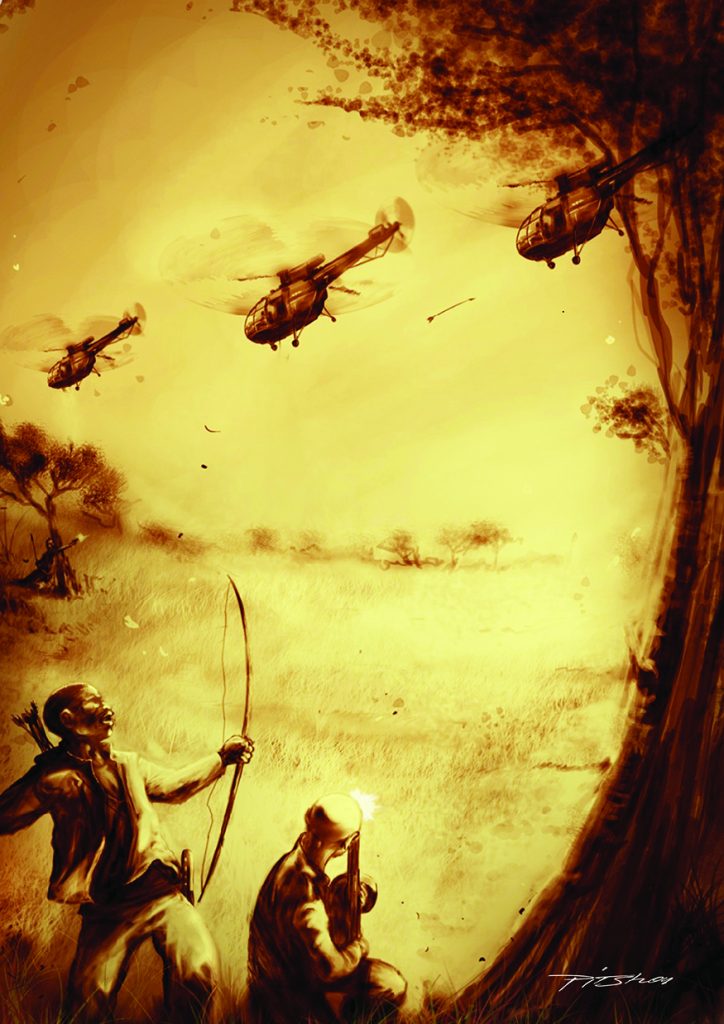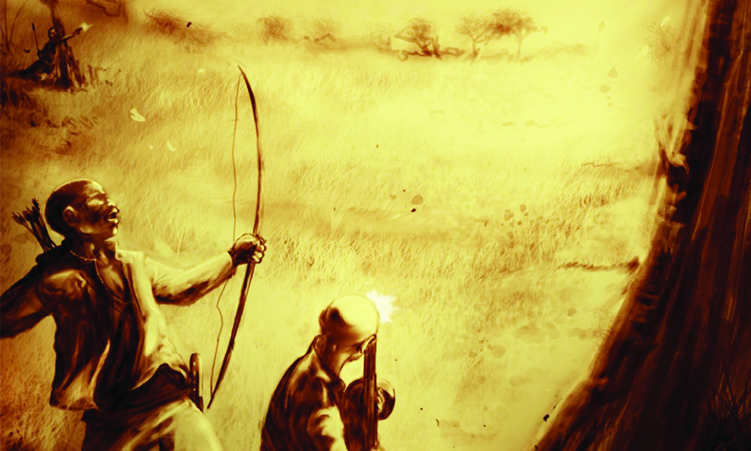As the saying goes: A picture is worth a thousand words.
The accompanying illustration is a defining visual image from a period of conflict that took place from 1966 to 1989, mostly in Angola and Namibia, then referred to as South West Africa.
It is hard to believe that peace in Namibia these days is often taken for granted and was preceded by a low-intensity war.
I created this illustration with Congo-born artist Pitshou Mampa.
The visual was inspired by a cartoon published in a local newspaper at a time when the war in northern Namibia was no laughing matter for the opposing forces.
Swapo fighters grouped as the People’s Liberation Army of Namibia (Plan) clashed with South African security forces for the first time at Ongulumbashe, just south of the Angolan border, in August 1966.
After being set up as the military wing of Swapo, Plan was recruiting ever-growing numbers of volunteers, especially in north-central Namibia, for training and deployment.
Fighters were trained in the Soviet Union, Cuba, Egypt and several countries in the then Eastern Block.

FIRST SKIRMISH
Shortly before his death, I interviewed the first Swapo cadre to cross the border bearing a gun. John Otto Nankudhu was a leader at one of the first Plan camps in Namibia, namely Ongulumbashe.
Nankudhu survived unscathed to tell the tale of the first skirmish in a conflict that dragged on for 23 years.
On 14 March 1965, the first six Plan cadres left Tanzania, each with a Russian sub-machine gun and a Tokarev pistol and ammunition.
They travelled mainly on foot. Nankudhu told me he had walked over 6 000km from Tanzania to Namibia “to open the front in Namibia” and “to establish training camps”.
However, according to members of the South African security forces, such was the disparity in resources at the time that in addition to guns, they also had to face bows and arrows at the scene of the first documented skirmish.
I had the rare opportunity to ask Nankudhu in person whether there was any truth in this claim.
He explained to me in detail what had happened that day.
By means of aerial photographs, the then security forces had determined the exact position of the base at Ongulumbashe and decided to attack the base from the air with the help of helicopters.
Based on intelligence provided by a double agent known as ‘the Major’, Nankudhu assured me they had expected the attack.
FIGHTING WITH BOW AND ARROW
Nankudhu continued that one of the members in his team of liberation fighters, an elderly man, had only a bow and arrow.
“And that gentleman, he shot the arrow towards the man who piloted the aeroplane, not to the aeroplane itself, to try and see whether he could down him with the bow and arrow,” he recounted.
Corroborated in supporting interviews by security forces at the time, roughly 23 cadres were fighting that day.
The security forces were dropped by helicopters, which then turned back to fetch reinforcements.
At this point, Nankudhu told his soldiers to retreat. While he had managed to escape, two insurgents died, and eight were taken prisoner. The base was taken in less than half an hour.
According to members of the South African security forces present at the time, the first prisoner repeated two sentences over and over: “I am Swapo, and I will not talk. I know I am going to die for my country.”
Some of the cadres might well have been old men at the time, armed only with outdated weapons, but time would tell that their dreams were very much alive, although it would take more than two decades for an independent Namibia to become a reality on 21 March 1990.
From the outset, the South African Defence Force (SADF) had more sophisticated weapons than Plan’s guerrillas.
However, the bush fighters’ arsenal (supported by their allies) developed with the changing face of the war.
Operating behind cadres, the heavier weaponry provided by the Soviet Union changed the nature of the war insofar as it introduced armoured vehicles in the mid-eighties, as well as radar-controlled anti-aircraft artillery and missiles.
The war escalated, since this development had to be matched by the SADF and its allies.
Revisiting the Ongulumbashe image depicted here, I once again paused to reflect that David, armed with a sling and a stone – or a bow and arrow – can become Goliath, and vice versa in the blink of an eye.
Namibia stands as a vivid and dynamic symbol of peace.
In our conflict-ridden world of today, Namibian history illustrates that – unlikely as it may seem – peace is always possible.
Most importantly, maintaining that peace is the actual challenge presented by the country’s journey into the future.
- * Linda de Jager is a television producer and journalist. Her work includes the television series ‘Grensoorlog’/’Bush War’ on the war in northern Namibia and Angola.
Stay informed with The Namibian – your source for credible journalism. Get in-depth reporting and opinions for
only N$85 a month. Invest in journalism, invest in democracy –
Subscribe Now!






